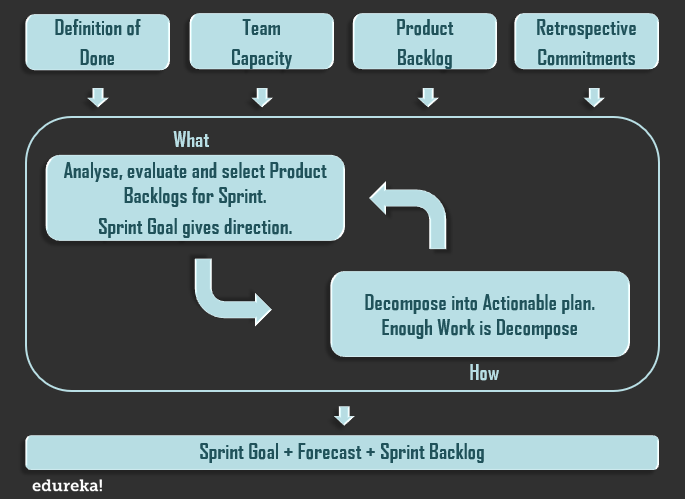PMP Certification Training
- 87k Enrolled Learners
- Weekend/Weekday
- Live Class
To extract twice the work in half the time, you need a solid plan. In Scrum, such plans are called Sprint Plans and what follows, hopefully, is going to be a complete breakdown of the same.
To learn how to effectively optimise the resources of your organisation, it’s highly encouraged to Get Certified as a Scrum Master. This will open up an ocean of opportunities in every domain.
So, for the development of any product, you need a plan where your team can figure out the following:
A Sprint plan is meant to answer all these questions in the Scrum framework.
Sprint Plans are meant for the team to determine the product backlog items they will work on during the period of that sprint. It discusses their initial plan for completing what needs to be done in the most optimised fashion.
Most Teams may find it helpful to establish a sprint goal and use that as the basis by which they determine which product backlog items they work on during that sprint.

Sprint plans typically involve the entire team.
A Product Owner is the one that proposes the Sprint Goal and priorities as well as identifying backlog items.
The team determines the number of product backlog items they forecast they will be able to complete and how will they deliver on time.
The Scrum Master facilitates sprint planning in order to ensure that the discussion is effective and that the appropriate product backlog items are included in the sprint backlog. He/She also ensures that there is an agreement to the sprint goal.
Prerequisites of Effective Sprint Planning
There are certain prerequisites you need to take care of to hold effective sprint planning, such as the following.
A sprint planning meeting is split into two parts, typically.
The team selects which items from a prioritised list of existing product backlog items they predict they will be able to complete during the sprint.
The following is a set of sample questions asked on the meeting agenda.
In this step, the team discusses how they will deliver the selected product backlog items in detail. This may include identifying tasks for the product backlog items. This weighs any dependencies between the items and signing up for the initial product backlog items to each member on the team.
In an agile environment, a time-box is defined as a period of time during which a task must be accomplished. Time-boxes are commonly known to be used in the risk-management of software development.
The teams are continually tasked with producing a releasable improvement to software, producing potentially shippable products time-boxed to a specific number of weeks.
A sprint planning meeting should be time-boxed at 8 hours a month or 2 hours a week for a one-month Sprint. The shorter the Sprint, the shorter is the time-box for Sprint Planning.
Created during the Sprint Planning Meeting, the Sprint Goal is an aim set for the Sprint. It can be met through the implementation of Product Backlog. It provides guidance to the Development Team on why the Increment is built. The Sprint Goal gives the Team some flexibility regarding the functionality implemented within the Sprint.
The main benefit of sprint planning is visibility. This allows a team to start a new sprint with an understanding of what they will work on for that sprint. It serves as an initial plan for how they approach that work.
Apart from this, there are other benefits of Sprint Planning as well, namely;
Sprint planning can become highly ineffective when your team does not have a well-refined product backlog from which to draw product backlog items.
This can be addressed by establishing a consistent backlog refinement process that results in a set of product backlog items that meet an agreed-to definition of ‘done’. These product backlog items can then serve as the potential product backlog items you consider for inclusion in the sprint.
Another obstacle arises when you don’t establish a specific goal for the sprint and wind up with a set of unrelated items that everyone has to work on, which results in a sprint’s worth of work but no noticeable progress.
Sprint plans are one of the original Scrum events and were created as part of the framework. Typically used when your team is following either Scrum or any other time-boxed iterations. If you’re following a flow-based approach, you may still find it effective to understand this subject to build a shared understanding of the items that are queued up to work on next.
 Thank you for registering Join Edureka Meetup community for 100+ Free Webinars each month JOIN MEETUP GROUP
Thank you for registering Join Edureka Meetup community for 100+ Free Webinars each month JOIN MEETUP GROUPedureka.co